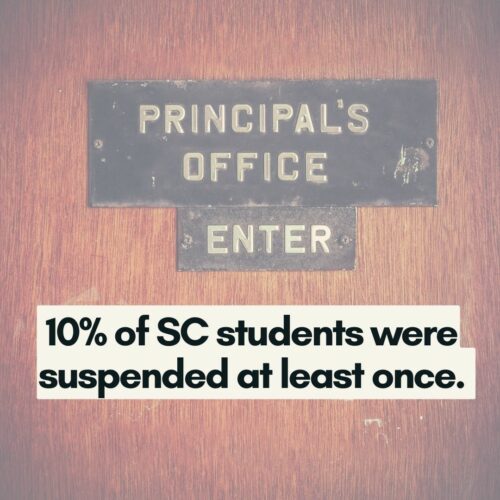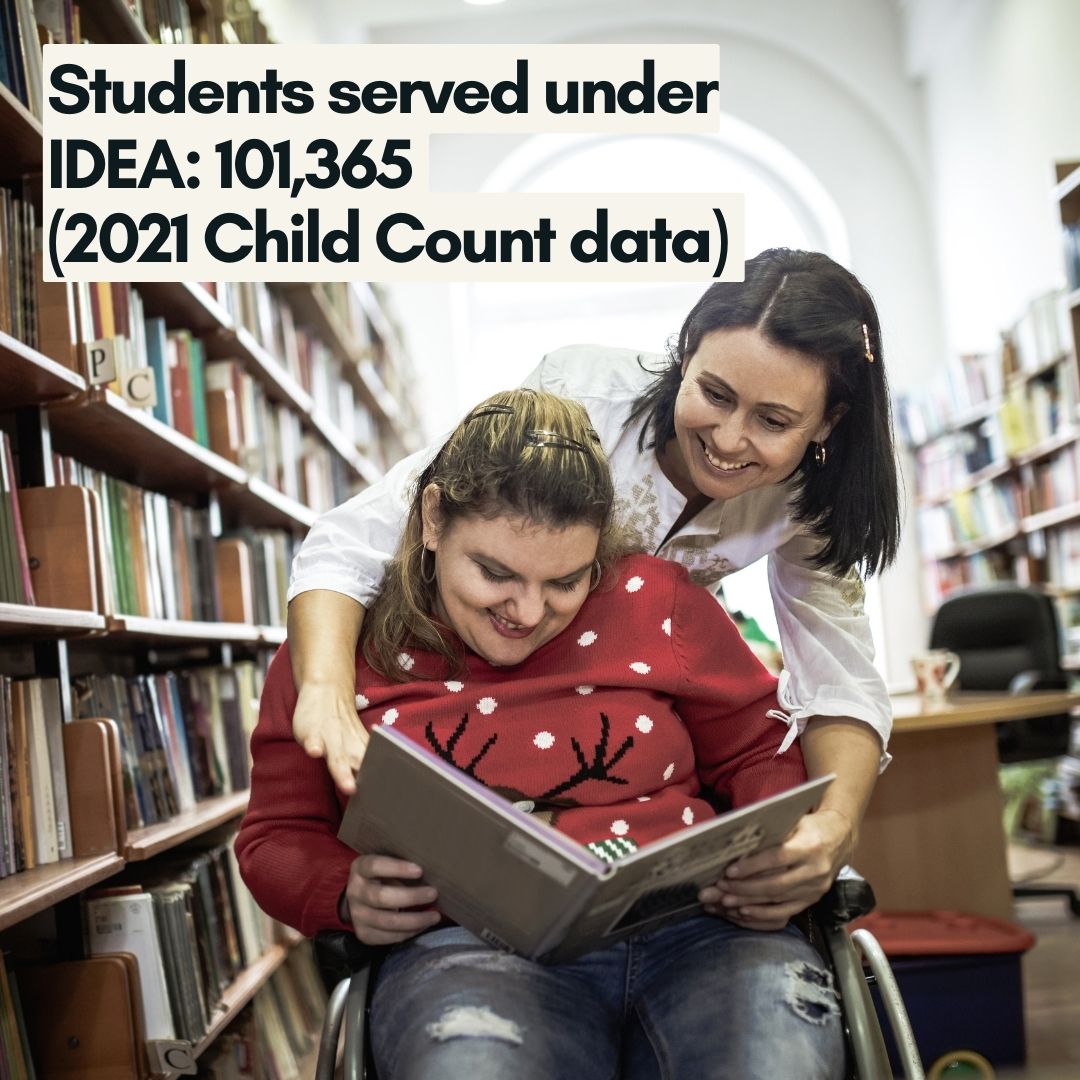Posted in Uncategorized
Written by Jennifer Rainville, Education Policy Attorney
When discussing criminal justice, we often focus on adults in the system, but the unfortunate truth is that interaction with the criminal system isn’t limited to adults. And in South Carolina, a state that expels more preschool children from school than any other state, getting caught up in the criminal justice system at a young age is all the more likely. Many behaviors that children have end up being categorized as criminal when in fact they are behaviors that are a symptom of a larger issue in a child’s life.
In the second blog of our three-part series centered around criminal justice, our Education Policy Attorney Jennifer Rainville discusses how school suspensions at an early age can greatly shape a child’s future as early as preschool. If you haven’t, make sure you visit the first part of our series which focuses on the intersection of housing and criminal justice.
You have probably heard phrases like “school to prison pipeline,” “fingerpaints to fingerprints,” or “schoolhouse to jailhouse.” This is the idea that there are policies and practices that are happening in our schools that push students out of school and into our criminal justice system.
Pushing students out of school starts astonishingly early. South Carolina suspends more preschool students than any other state and the most recent data suggests that this problem is getting worse. You may have seen the news stories, heard from friends, or even experienced yourselves all of the school staffing shortages in the state and all of the discipline problems going on in the classroom. Students are struggling. Parents are struggling. Teachers are struggling. The system is stressed out and everyone is paying the price for it, especially our children. What is contributing to this issue exactly?
Defining Challenging Behavior
Before we speak on the issue of suspensions and expulsions, let’s define what a challenging behavior is. This means any behavior that disrupts the learning environment. This could be as simple as not following the teacher’s directions or as complicated as a school yard fight. While physical fighting is never okay, is a simple school yard fight something that a child should have a criminal record over?
The answer is no. As children are learning to develop their problem-solving skills, they will make wrong choices. We all do, from time to time. But the decision to push a bully or return a shove from another student should not have lifelong consequences.

The Impact of Implicit Bias
Studies show that children who are most likely to be suspended or expelled are students of color and students with disabilities. Let’s break this down further into two categories.
First, we have implicit bias. There is a study by Dr. Walter Gilliam, where he had early educators watch a video of four children playing. He told them to press a button each time they saw behavior that “may become a potential challenge.” The four children in the video were a Black boy, a white boy, a Black girl, and a white girl playing at a table. There was no challenging behavior in the video. Instead, the video was using eye tracking software to track where the early educators were looking. All the early educators spent significantly more time looking at the Black boy-more than any other child. If educators are anticipating challenging behavior, they are going to be more likely to find it, which might explain some of why we see children of color more likely to be suspended and expelled.
Second, we have children who are not getting what they need. Behavior is communication. Sometimes even adults do not have the words for what they are feeling or fully understand what they need. This is even more true for children. Many times, challenging behaviors may be the result of a deeper problem with a child.
For many children, access to basic needs is the issue. 20% of South Carolina children live in poverty. If a child is hungry, they are not going to be focused on learning. If a child is worried about where they are going to sleep tonight, they are going to struggle to master their multiplication tables. If a child’s basic needs are not being met, they are not going to be able to achieve their full potential in the classroom or in life. Likewise, if a child has a disability, they are more likely than their non-disabled peers to be suspended or expelled.
How Do School Resource Officers Play a Role in This?
90% of South Carolina schools have a School Resource officer assigned to their campus. School resource officers are police officers who are trained to view challenging behavior the same way as they would a criminal act on the streets. As a result, a simple school yard fight can end up being classified as assault and battery.
Nationally, we have seen students as young as six arrested by school resource officers. While the safety of our students in schools is paramount, we need to make sure that officers have the tools that they need to deal with challenging behavior of students, learn how to properly deescalate children, and understand how to deal with a student who has a disability.
Children are not equipped with the same decision-making abilities as adults, nor are they able to comprehend lifelong consequences of one simple act. Most challenging behaviors are learning opportunities for children to better understand themselves and the world and children should not be treated as little adults.
By the Numbers: SC Student Data for 2022-2023
In-school suspensions: 101,407
Students with out of school suspensions: 95982
Students expelled: 1,422
School related arrests and referrals to law enforcement: 3,413
How Proper Support Can Change a Child’s Life Altogether
There are federal laws that protect children with disabilities: Individuals with Disabilities Education Act (IDEA) and Section 504 of the Rehabilitation Act. IDEA gives students specialized instruction and related services designed to meet their unique needs. The purpose of IDEA is to make sure that students with disabilities receive equal educational opportunities. This includes:
- getting to fully participate in academic, non-academic, and extracurricular activities;
- independent living; and,
- economic self-sufficiency.
IDEA makes it clear that no two students with a disability are the same and if schools address the unique needs of students they will perform better and be better suited to live on their own and support themselves as adults.
Let’s take Jonathan as an example. Jonathan has ADHD and a learning disability. He has behaviors that are challenging and frequently lead to him getting removed from the classroom. Jonathan struggles to sit still and stay focused. When he feels confused during instruction, his behavior can get even more challenging. He may make jokes and be disruptive to avoid having anyone notice he is struggling. Jonathan’s teacher may call his parents to pick him up early or send him to the principal’s office. When that does not work, they may suspend him, then eventually recommend him for expulsion.

Jonathan does not need less time in the classroom and away from instruction. If he is struggling, removing him from instruction is only going to put him further behind. It is also going to make him feel like school is not for him. Maybe it even makes him feel unintelligent. He is also going to feel like they do not want him in school. Does anyone want to go somewhere that they feel unwanted? If Jonathan is not in school, he is more likely to end up in the juvenile justice system, and in adulthood more likely to be incarcerated.
But if Jonathan’s disability is addressed and he receives the services he needs to be successful in school, he is going to be less likely to act out and be a disruption. Under IDEA he can get specialized instruction to help him better cope with his learning disability and perhaps close the gap between him and his peers. This may lead to him being a more engaged learner, which will help his behavior. He can also receive instruction about his behavior and learn coping skills that can better help him study and stay organized. He might receive accommodations to help him better focus better in the classroom. Under IDEA he will also receive services to help him plan for life after high school. This could be things like how to achieve his career goals whether those are being a mechanic or an engineer. If Jonathan gets a quality education that addresses his needs, he will end up being ready for the workforce and adulthood. He is less likely to be incarcerated.
The Power of Public Education
This is why public education is so important. Public education is guaranteed to every child no matter their socioeconomic status, nationality, race, or disability. If we do a better job supporting our students and teachers, we can increase positive outcomes for our families. We can move the needle on poverty, reduce incarceration of our young people, and make South Carolina a better place for everyone – especially our future.
Resources
If you want to learn more about educational rights of children, please visit our Parent Guide located here: https://www.scjustice.org/south-carolina-parent-guide-for-k-12-students/
If want a workshop learning more about educational rights, please reach out to [email protected]

